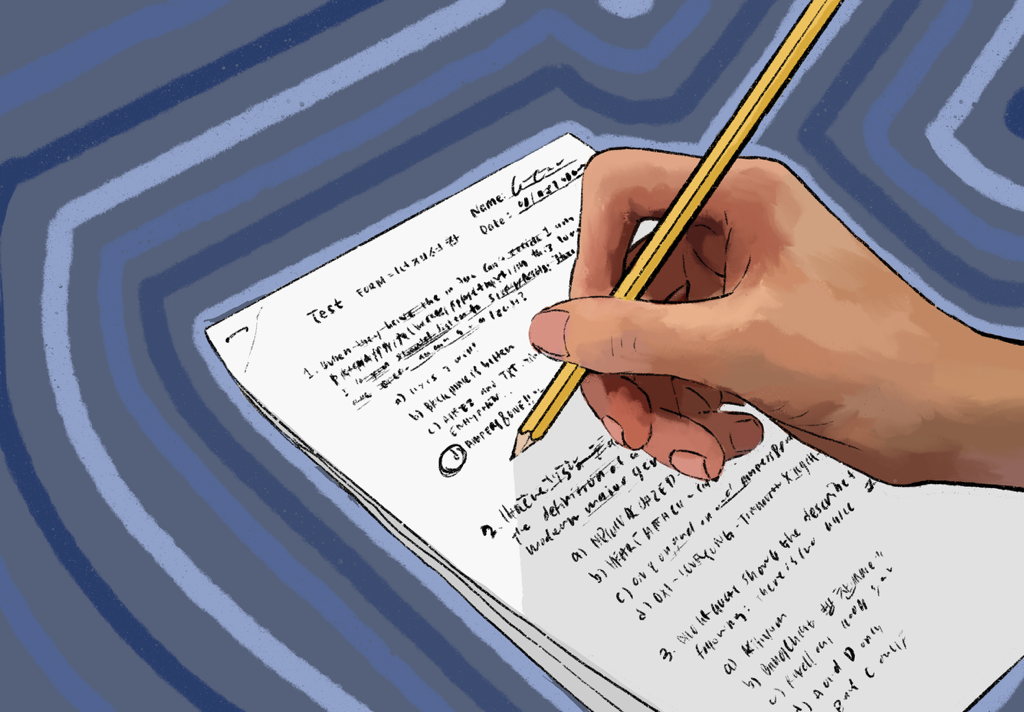
By Fiona Fu ’25
Disclaimer: I would like to preface my argument by noting that not everyone is able to handwrite due to various circumstances. This article is not intended to detract from the importance of typing accommodations and is written from the perspective of someone whose sole issue with handwriting is a cramping hand.
After reading that headline, you probably think I’m crazy. You’re thinking, “she’s the type to ask the teacher for homework” (which for the record, I am not). I say this because every time a teacher announced an in-class, handwritten assessment, I would react the same way you would — groan and complain about how hard and unfair it would be.
Although I will probably keep complaining because that’s part of the fun of being a student, I’ve discovered a newfound appreciation for both the practical benefits and the artistry of handwritten tests, papers, and notes. Not only have both research and personal experience shown me that writing by hand is a much more effective way to learn, but I also find that in-class, handwritten assessments alleviate a lot of my stress.
Most teachers who require handwritten in-class tests do so out of concern for academic integrity. According to Humanities teacher (and notorious paper-and-pen assignment-giver) Ms. Amy Salot, “The only kind [of assessment] that I would require written by hand would be in-class where I don’t want my students to have any access to outside materials.” Handwritten humanities tests can more accurately reflect a student’s understanding of not just the material, but the critical skills required to digest it; the temptation to quickly Google something is eliminated, and students are forced to think spontaneously.
For example, in a recent in-class explication of Emily Dickinson’s poetry, I had to demonstrate my ability to read and analyze a poem I’d never seen before — not simply be good at paraphrasing my notes, my teacher’s analysis, or the internet. These tests also help to prepare students for standardized tests like the AP exams, which are done on paper.
In-class handwriting assessments also force me to focus on the content of the work, not necessarily the sentence structures, grammatical gimmicks, or word choices. While these are all crucial writing skills, it’s a welcome break to save time by using my own vocabulary instead of a four-syllable synonym from a thesaurus.
The efficient nature of these assessments saves not just time, but the mental stress I experience with take-home papers (to which there is no limit on how long I can spend agonizing over whether it is perfect). To assuage any quality concerns, Ms. Salot, who has graded both handwritten and typed assessments, noted that the content of the former is equal to that of the latter, though the quality of students’ spelling is bound to take a hit.
My preference for note-taking by hand reflects what is most important to me as a student; I care about retaining the most important information, not parroting every single word that my teacher says. Research has demonstrated that handwriting leads to more effective memory recall. Furthermore, because the notes are written in your own words and handwriting, it’s easier to remember and understand a concept.
I also appreciate that handwriting forces me to be fully present. As fast and easy it is for me to type, I tend to transcribe exactly what my teachers say or copy and paste from the textbook I’m reading. However, note-taking by hand forces me to synthesize the information and identify the key points simply because I do not have the time to write out every word. This process helps me to remember what I’ve learned and keeps me on task.
Finally, I like that handwritten assignments force students to actively utilize their handwriting and remember that it still exists. Call me old-fashioned, but I firmly believe that a handwritten card or letter is 10 times better to receive than the best-written email. A handwritten note demonstrates that the sender cared enough to spend the time and effort to write out the message, and because everyone’s handwriting is unique, it is so much more personal. I, for one, stick every single handwritten card I receive on my wall, and it brings me joy whenever I’m down or lonely. Essentially, I like handwriting because it reminds us that we can still write by hand, and I don’t want that culture to eventually die out.
Of course, like most people my age, I don’t think I could survive without my laptop. I would’ve hated it if I had to write this article on paper instead of typing it out in a Google Doc. Nevertheless, I appreciate that handwriting still has a variety of benefits, and I am glad we have a mix of both handwritten and typed assignments at Choate.




